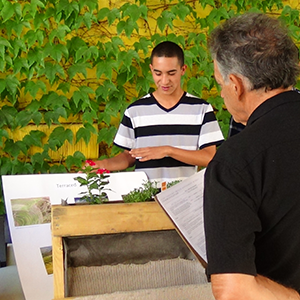
After three years of Buck Institute training for teachers and leaders to develop capacity to do high quality Project Based Learning, our school needed a catalytic experience to push the work forward by authentically engaging parents and students in creating a culture where student voice and choice matter. Moving to learner-centered classrooms requires intentional moves school-wide to support the critical work. To this end, Bassett High teachers joined in a learning partnership with DSX, an educational organization that works with schools and school leaders to co-design and build creative courage for equity in education.
At the Coffee Shop
It all started in the summer when teacher leaders spent a warm day at a coffee shop designing a reunion experience that invited participants to practice the design thinking process, often used in PBL. The goal was to defibrillate the creative muscle inherent in all adults AND feel the power of equity and empathy as a means to develop a genuine understanding of students and parents at the high school. From these ideas, David Clifford and Corrina Hui, DSX founding Systemic Equity Designers and I developed the following driving question for our work this school year: “How might we co-create a culture of belonging at Bassett High School?”
Clifford then ran a quick brainstorm session with the teacher leaders to explore how they could see using Liberatory Design Thinking at Bassett. What emerged was quite interesting: not one person mentioned academic classes. All their ideas were related to school culture. By practicing the collaborative strategies found in Liberatory Design Thinking, we identified design challenges that would help answer the driving question with students and parents. They were invited to join teachers in design teams on our first day of professional development in August.
Teacher PD Day 1
On August 1, more teachers were invited to learn the process of Liberatory Design Thinking in a workshop presented by DSX. Teachers engaged in sustained inquiry through the process as a means to develop empathy and understanding for students and parents. The work began to develop the creative muscles necessary to tackle some of the challenging problems that exist in Bassett High School’s community.
I invited parents and students based on their involvement and engagement in different aspects of campus life. I invited athletes and their parents, members of ASB, parent leaders from the English Learner Advisory council, a parent of a special education student, and leadership from the Parent Teacher Association. As I was describing the process to parents and students, I immediately learned that “new and exciting” is not always felt by everyone. I was met by skepticism from parents about how I invited them and my purpose was questioned. Quite honestly, I had the fear that a big risk I was taking as a school leader was about to go horribly wrong. Yet we persisted together, I answered their questions, and asked for grace.
And they gave it. The parents, students, and teachers engaged in the design thinking process together in order to model the process of collaboration, inquiry, and critical thinking necessary in order to have success with Project Based Learning process in the classroom.
The parent-student portion of workshop moved in phases. First, students and parents were invited in to be interviewed by teachers based on their design challenge. These interviews were ways to gain empathy for the experiences of the students and parents. The teachers asked questions, students and parents responded, and the teachers... just listened.
Then, in a deviation from traditional design thinking, the teachers invited the students and parents to stay and join the design team and actually co-design approaches to the problems they named. National Equity Project and DSX believe people can solve their own problems. This is agency. The lack of agency is oppression and when students and parents feel oppressed they fight for their dignity and children or worse – they disengage from school. I wanted to make sure we designed for belonging, so we started by inviting and designing WITH them, not just FOR them.
The teams engaged in powerful dialogues to develop understanding of needs and developed prototypes to best meet the needs uncovered in the process of sustained inquiry. There was joy on the faces of parents and students as they felt they were being listened to about authentic challenges that complicated the relationship between school and community. And after about two hours of designing and reflection in a room together, parents, students, and teachers had ideas for projects and experiences that help create the culture of belonging at Bassett High School which has started to flourish.
Big takeaways:
- All schools should use a process of involving students and parents in professional development to develop empathy as a way to understand student voice prior to engaging in academic tasks.
- The risk of failure is worth the reward of success and we as leaders must model AND create the culture that invites and celebrate failure, not just risk taking.
- Modeling the PBL process with teachers in collaboration with parents and students is a great way to build trust and communication skills, which are foundational to PBL’s success.
Want to learn more about PBL? Check out our books.

